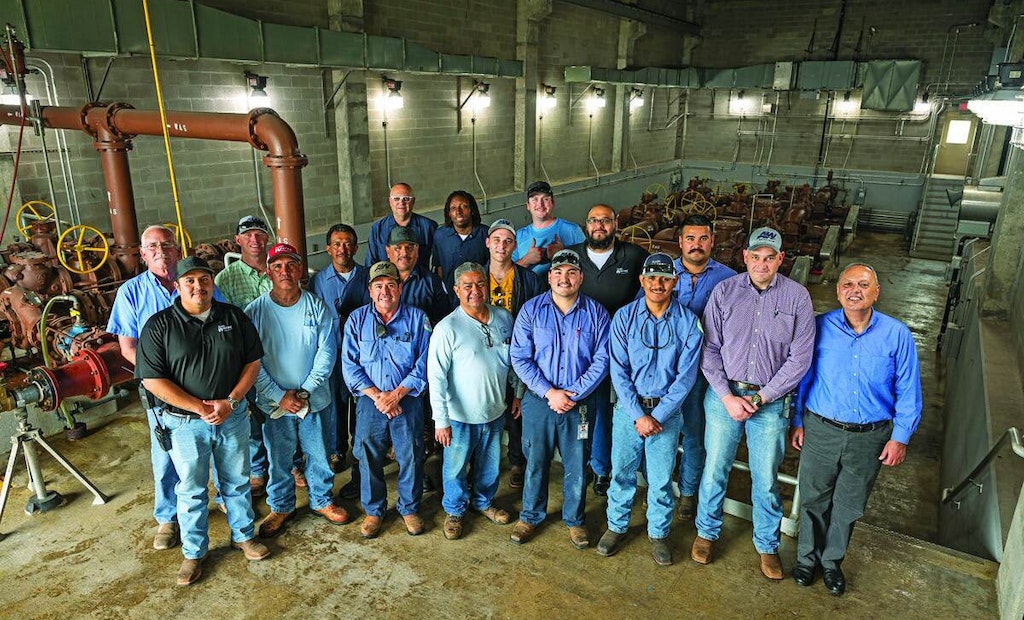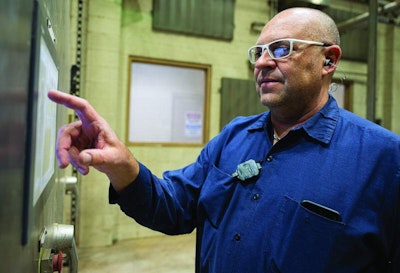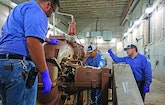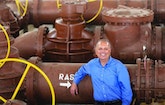
The team at the South Austin Regional Wastewater Treatment Plant includes, front row, from left, Tony Luna, operations and maintenance supervisor; Enrique Zepeda, O&M associate; Juan Maldonado, equipment operator; Adam Rodriguez, O&M senior; Efrain Lopez, O&M associate; Filiberto Castilleja, O&M senior; Mark Reeh, O&M superintendent; Ayman Benyamin, operations manager; second row, Richard O’Donnell and Chris Mancuso, O&M supervisors; Ysidro Lucio and Lee Montoya, O&M seniors; Shea Quinn, treatment plant worker; David Juarez, utility logistics planner coordinator; Matthew Barber, O&M associate; third row, Mark Prochnow, O&M senior; Antonio Jumper, O&M associate; and Brandon Hill, O&M assistant.
Interested in Treatment?
Get Treatment articles, news and videos right in your inbox! Sign up now.
Treatment + Get AlertsGrowing cities have to pay big to sustain wastewater treatment capacity and meet permit limits. Austin Water does so with conviction.
For illustration, look no farther than the 75 mgd (design) South Austin Regional Wastewater Treatment Plant, one of two major clean-water facilities in the capital city of Texas. Several years ago the city invested $20 million to upgrade the plant’s aeration system.
At present, the operations team is investing $120 million to completely refurbish the electrical system of old older treatment trains that date back to the 1980s. Meanwhile, the 75 mgd (design) Walnut Creek Wastewater Treatment Plant is seeing the deployment of artificial intelligence visual management tools, through predictive maintenance and machinery learning to increase maintenance productivity, improve reliability and reduce long-term operating costs.
Ayman Benyamin, P.E., Austin Water operations manager, sees such investments as essential to delivering high-quality, cost-effective service to the community and for protecting the environment in a city with a reputation for being green. They’re also economically sound, as shown by the aeration upgrade. “The return on investment in that project was six years,” Benyamin says.
Recognizing these and other accomplishments, the Water Environment Association of Texas recognized South Austin as the 2022 Municipal Wastewater Treatment Plant of the Year. The plant has also received several Gold and Silver Peak Performance Awards from the National Association of Clean Water Agencies.
Three trains
The Austin Water wastewater system consists of the two major plants, the Hornsby Bend central biosolids composting facility, and nine smaller remote wastewater treatment facilities located around the city, with capacities from 0.3 to 2.25 mgd.
The South Austin plant (average flow 41 mgd) was built in three phases starting in the early 1980s. It consists of Plant A, the original treatment train; Plant B added soon afterward to accommodate exponential growth in the city; and Plant C, built in the 1990s. All three 25 mgd (design) plants use the conventional activated sludge process.
Influent arrives via two lift stations, one receiving flow from the Onion Creek Tunnel flow and the other from the Downtown and Govalle tunnels, which in addition to conveyance can provide storage during 100- and 500-year wet-weather events. The pumps in both stations (Flowserve and Pentair Fairbanks Nijhuis) deliver wastewater to an influent splitter that divides the flow to the three treatment trains.
Each train includes Infilco Degremont bar screens (Veolia Water Technologies & Solutions) and grit removal basins. After primary clarification, the flow enters the aeration basins, followed by secondary clarifiers, disinfection with sodium hypochlorite and tertiary treatment with 24 units of cloth-media rotary disc filter assemblies (Aqua-Aerobic Systems). About 95% of the final effluent discharges to Onion Creek, a Colorado River tributary.
“We produce the highest effluent quality with the lowest E. coli level, so we can use it anywhere, with or without people’s presence,” Benyamin says. “We reuse about 5% of what we produce.
Beneficial use
Primary and waste activated sludges pass through a gravity thickener (Ovivo) before being pumped via pipeline to the Hornsby Bend site at 2% solids to be converted to Class A composts.
The primary Class A product, branded Dillo Dirt, is one of the nation’s oldest biosolids formulations, suitable for unrestricted use, including for vegetable gardens. “We also provide a multitude of Class A composts for agriculture,” Benyamin says. “We’re trying to expand the market so we can sell 100% of our compost, not just for gardens but also for agriculture. Right now, we’re in the sixth year of a contract with Synagro and have eliminated Class B land application, except in emergencies, none of which have occurred in the last six years.”
The biosolids program has been streamlined to the tune of $2 million in annual savings by turning all Hornsby Bend operations over to Synagro. In the process seven Austin Water team members were assigned to new roles in the wastewater organization. “With Synagro, we really bought their marketing ability,” says Benyamin. “We created an incentive for them to take the product off the site.
Boosting performance
At South Austin, Benyamin and his team are proud of two major projects, one completed and the other just beginning. Six years ago a $20 million project centralized the air supply for the plant’s three treatment trains, providing savings of $2.5 million per year in power costs alone.
Previously, each train had its own blowers, and those in Plants A and B were old and inefficient. The entire plant has been revamped to connect with three Turblex single-stage centrifugal blowers (Howden) (combined capacity of 13,500 scfm) with the air systems in Plant A and Plant B. “Now we have better control over air distribution and almost zero leakage,” Benyamin notes. The project included replacement of the aeration basin diffusers with a ceramic-disk fine-bubble diffused aeration system (Sanitaire, a Xylem brand).
At present, the entire electrical systems in Plants A and B are being refurbished: “We’re basically replacing all the old conduits, manholes and motor control centers in both plants. It is costing us about $2 per gallon of treatment capacity.” Completion is expected in 2024.
The key challenge in that project is the need to take one train out of service at a time to complete the work, substantially reducing the facility’s surplus capacity. Says Benyamin, “For the next four and a half years we’ll be running with about 50 mgd capacity available, while treating about 41 mgd average flow. The saving grace is our tunnels, which each can store one day’s worth of flow.”
Broader initiatives
Across Austin’s wastewater system, Benyamin and his team are focused on safety. “My job is to make sure that our team members go home at the end of the day with ten fingers, ten toes and a head,” says Benyamin. “That is my top priority.”
Toward that end, standard operating guidelines have been developed for multiple work processes, which include dealing with emergencies. SOGs differ from standard operating procedures in being more flexible. “For example, in preparation for a storm, we have SOGs with work orders that need to be followed. They include measures to mitigate any risk we can foresee. We review the SOGs every year and update them as we find weaknesses and improvement opportunities.”
Another point of emphasis is predictive maintenance, which includes applying artificial intelligence and machine learning at the Walnut Creek treatment plant and the 2.25 mgd Wild Horse Wastewater Treatment Plant. (The South Austin plant will become part of that initiative when it is expanded starting in 2034).
Walnut Creek has two conventional activated sludge treatment trains with redundant aeration basins. It has an average flow of 60 mgd and an expansion of design capacity to 100 mgd by 2028 is in the design stage.
“We are implementing AI in the Walnut Creek expansion,” Benyamin says. “Instead of running like chickens with our heads cut off, we want to increase visual management and red-flag trouble so we can focus early on the most critical failures to prevent.
“Basically, we’ll be enabling the machines to talk to us. A sensor on the motor, for example, will tell us if a bearing is off center or there is some extra heat. In one situation with a pump, because of the machine talking to us, we were able to fix the problem for $400, instead of $25,000.
“We studied what technologies are available in the market. We brought in experts from Emerson, Rockwell and Honeywell to tell us what is the latest in AI. Our goal is to know very early on if there is an issue with our expensive equipment. AI will tell us if there are parts that need to be replaced in X number of months based on machine learning.”
The technology is to be deployed on large equipment such as pumps, motors and blowers, essentially all items 50 hp and above. “We expect to reduce our preventive maintenance hours and increase our equipment availability and resilience,” Benyamin says. “We’ll be better able to focus our workforce on areas that have problems, while also making more informed decisions on our capital improvement program spending.”
In addition, an enterprise asset management program will create an extensive database on the equipment in the field and the condition of each item. It’s a way of more reliably retaining institutional knowledge: “We’re making it so the database is the knowledge.”
Sustaining the team
Key members of the South Austin plant team are Agmed Weber, division manager; Mark Reeh, treatment superintendent; Richard O’Donnell, chief operator; and Tony Luna and Chris Mancuso, operation and maintenance supervisors. All told, the plant has 27 licensed wastewater operators, including two Class A (highest), 19 Class B, and six Class C.
Staffing is a continual challenge for Austin Water because the utility needs to compete with smaller surrounding cities that offer fewer services, have less overhead, and so have more money available for salaries.
“Austin is a very environmentally conscious city, and we have certain sunk costs that other utilities don’t have,” Benyamin says. “On the other hand, our staff gets the benefit of a large organization with a lot of support functions that make their jobs easier.” Among perks for team members are stipends for earning licenses at levels above the minimum required for their roles.
A high-quality team is essential to meeting the daily challenge of operating a 75 mgd facility. Says Benyamin, “In wastewater, we have no way to divert. The influent is coming, and we have to be ready. There is no waiting for tomorrow.”








